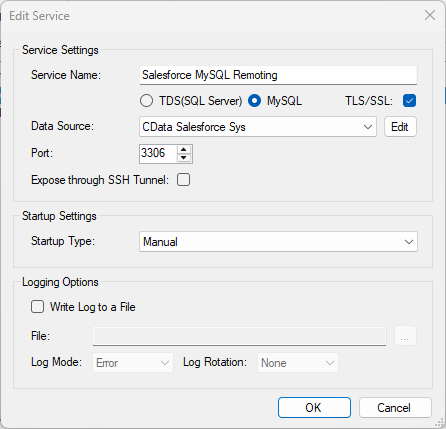Discover how a bimodal integration strategy can address the major data management challenges facing your organization today.
Get the Report →How to Query XML Data in MySQL Workbench
Execute MySQL queries against live XML data from MySQL Workbench.
You can use the SQL Gateway from the ODBC Driver for XML to query XML data through a MySQL interface. Follow the procedure below to start the MySQL remoting service of the SQL Gateway and work with live XML data in MySQL Workbench.
Connect to XML Data
If you have not already done so, provide values for the required connection properties in the data source name (DSN). You can use the built-in Microsoft ODBC Data Source Administrator to configure the DSN. This is also the last step of the driver installation. See the "Getting Started" chapter in the help documentation for a guide to using the Microsoft ODBC Data Source Administrator to create and configure a DSN.
See the Getting Started chapter in the data provider documentation to authenticate to your data source: The data provider models XML APIs as bidirectional database tables and XML files as read-only views (local files, files stored on popular cloud services, and FTP servers). The major authentication schemes are supported, including HTTP Basic, Digest, NTLM, OAuth, and FTP. See the Getting Started chapter in the data provider documentation for authentication guides.
After setting the URI and providing any authentication values, set DataModel to more closely match the data representation to the structure of your data.
The DataModel property is the controlling property over how your data is represented into tables and toggles the following basic configurations.
- Document (default): Model a top-level, document view of your XML data. The data provider returns nested elements as aggregates of data.
- FlattenedDocuments: Implicitly join nested documents and their parents into a single table.
- Relational: Return individual, related tables from hierarchical data. The tables contain a primary key and a foreign key that links to the parent document.
See the Modeling XML Data chapter for more information on configuring the relational representation. You will also find the sample data used in the following examples. The data includes entries for people, the cars they own, and various maintenance services performed on those cars.
Configure the SQL Gateway
See the SQL Gateway Overview to set up connectivity to XML data as a virtual MySQL database. You will configure a MySQL remoting service that listens for MySQL requests from clients. The service can be configured in the SQL Gateway UI.

Query XML from MySQL Workbench
The steps below outline connecting to the virtual XML database created in the SQL Gateway from MySQL Workbench and issuing basic queries to work with live XML data.
Connect to XML through the SQL Gateway
- In MySQL Workbench, click to add a new MySQL connection.
- Name the connection (CData SQL Gateway for XML).
- Set the Hostname, Port, and Username parameters to connect to the SQL Gateway.
- Click Store in Vault to set and store the password.
- Click Test Connection to ensure the connection is configured properly and click OK.

Query XML Data
- Open the connection you just created (CData SQL Gateway for XML).
- Click File -> New Query Tab.
- Write a SQL query to retrieve XML data, like SELECT * FROM `CData XML Sys`.people;

With access to live XML data from MySQL Workbench, you can easily query and update XML, just like you would a MySQL database. Get started now with a free, 30-day trial of the CData ODBC Driver for XML and the CData SQL Gateway.






